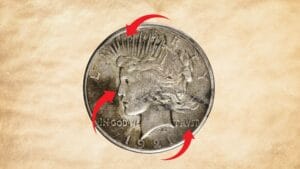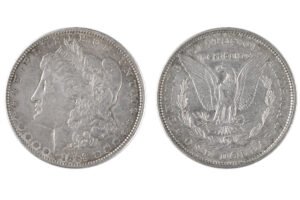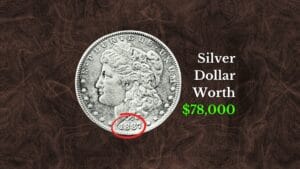Do you have an old one-dollar coin from 1974 in your pocket change? If yes, then you are about to get rich, because one 1974 Eisenhower Dollar coin just sold for a jaw-dropping $14,000 at an auction! Isn’t that crazy?
I’m sure you’re wondering if your 1974 dollar coin is worth the same amount or not! Let’s find it out in this price guide. It will explain all the value factors and rare features, such as condition, grades, mint marks, and errors that can make coin collectors pay hefty prices for your coin!

1974 Eisenhower Dollar History
The Eisenhower Dollar was first introduced in 1971, marking the return of the dollar coins to American currency after a 36-year hiatus. Designed by Frank Gasparro, the coin featured a portrait of President Dwight D. Eisenhower and an eagle landing on the moon, depicting the Apollo 11 mission.
The 1974 Dollar Coin is a significant part of this series. This year, the U.S. Mint continued producing this coin at all three facilities, reflecting its demand. As the coin became more popular, high-quality examples became more and more sought-after by collectors!
| 1974 Eisenhower Dollar | Key Facts |
| Coin Composition | 75% Copper, 25% Nickel over a pure Copper center; 40% Silver, 60% Copper (proof & Uncirculated) |
| Minting Location | Philadelphia, Denver, San Francisco |
| Year of Minting | 1974 |
| Weight | 22.68 grams (copper nickel clad); 24.624 grams (silver clad) |
| Diameter | 38.1 mm |
| Thickness | 2.5 mm |
| Designer | Frank Gasparro |
| Face Value | $1 (One Dollar) |
| Mint Marks | No Mint Mark – Philadelphia Mint, D – Denver Mint S – San Francisco Mint |
| Total Mintage | 78,702,303 coins |
Identify a 1974 Eisenhower Dollar Design & Composition
To spot a 1974 one dollar coin among other old coins, you need to get familiar with all its design elements on both sides, composition, and its physical characteristics.
1974 Eisenhower Dollar Obverse:
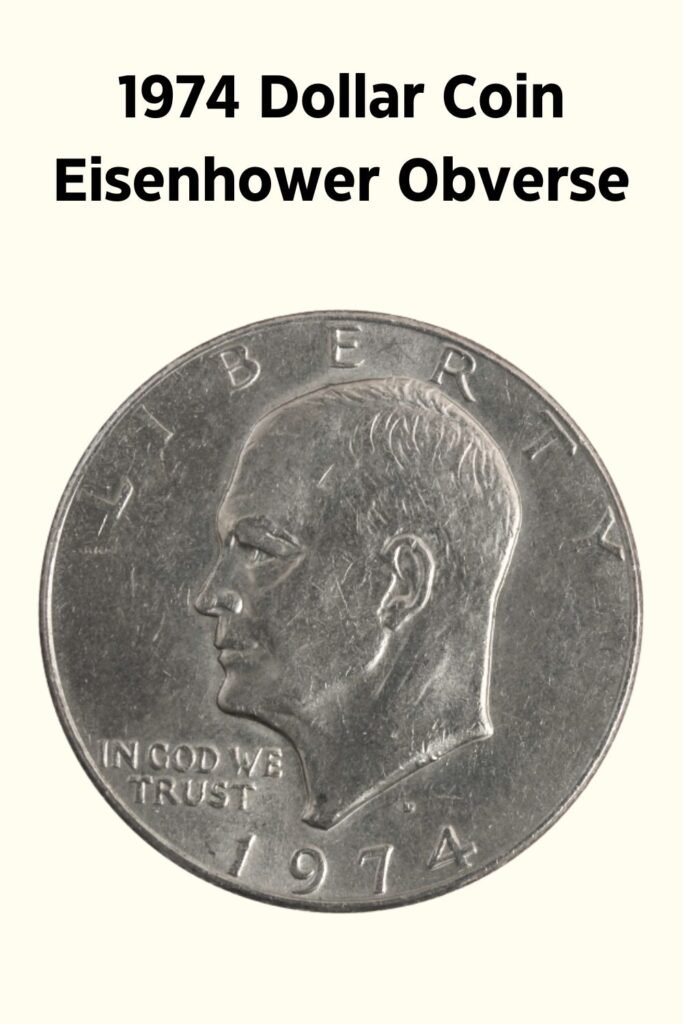
- Left-facing portrait of Dwight D Eisenhower
- The inscription “LIBERTY” along the upper edge
- The words “IN GOD WE TRUST.” to the left of Eisenhower’s neck
- The mint date “1974” at the bottom
- The mint mark, if present, below the truncation line
1974 Eisenhower Dollar Reverse
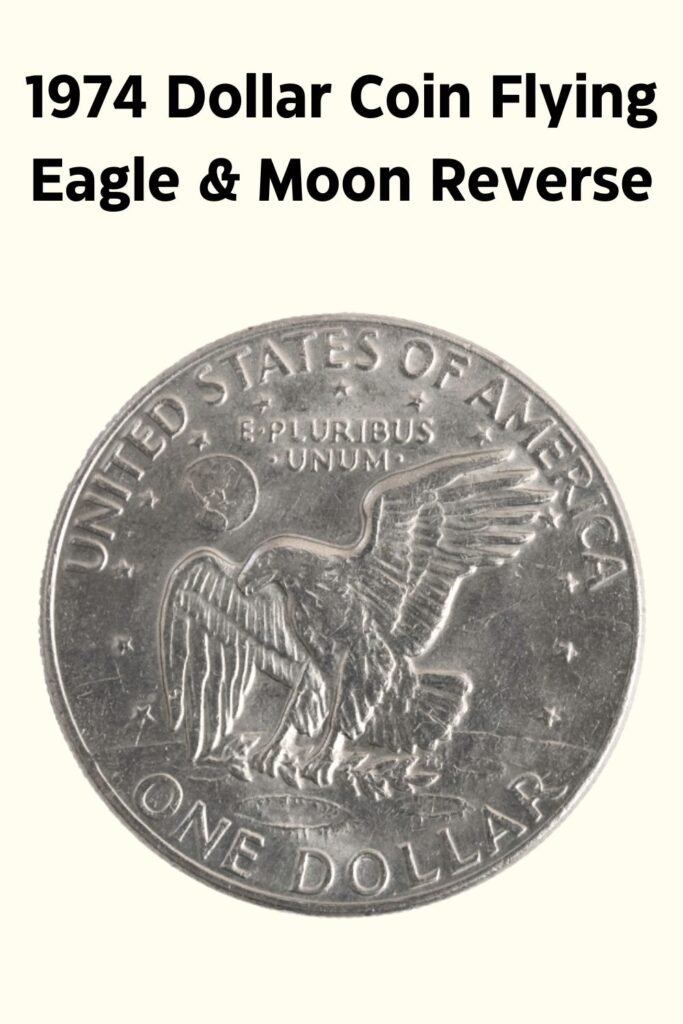
- A flying eagle landing on the moon
- The inscription “UNITED STATES OF AMERICA” along the upper half edge
- The denomination “ONE DOLLAR” at the bottom
- The words “E Pluribus Unum” above the eagle
- The designer’s initials “FG,” for Frank Gasparro, near the eagle’s tail
Coin Composition & Dimensions
The 1974 Eisenhower Dollar was produced in two distinct versions: silver and clad. Here are the composition and size details of both varieties:
- 1974 Eisenhower Clad Dollar: The Clad Version of the 1974 Eisenhower Dollar is made with an outer layer of 75% copper and 25% nickel, while the core consists of 100% copper. Due to this content, clad dollar coins are slightly lighter, weighing 22.68 grams.
- 1974 Silver Dollar: The silver-clad version of the 1974 Eisenhower Dollar has an upper layer of 80% silver and 20% copper and a center of 79% copper and 21% silver, giving it a 40% silver composition! A 1974 silver dollar weighs 24.62 grams!
As for the size, both 1974 Eisenhower dollar versions share the same diameter of 38.1 millimeters and thickness of 2.58 millimeters. Both coins also have the same well-reeded edge.
Finding a 1974 Dollar Coin Value (4 Key Factors)
On average, a 1974 Eisenhower One Dollar coin is worth around $1 to $2 in the circulated condition and $5 to $250 in the uncirculated condition. However, certain factors, such as grades, mint marks, and errors, can increase its value up to $14,000 or more!
Let’s understand these factors and special features in detail!
1. Coin Grading & Condition
The condition of a coin, professionally graded on a scale from Poor (P-1) to Mint State (MS-70), greatly affects its value. High-grade 1974 Eisenhower Dollar coins (MS65 or higher), or those with minimal wear, strong strikes, and clear details, are generally worth more than lower-grade and worn coin coins.
2. Mint Marks & Mintage

The 1974 Eisenhower Dollar was minted at three locations: Philadelphia, Denver, and San Francisco, all with different mint marks. Each mint mark and its mintage impact the coin’s rarity and value.
- 1974 No Mint Mark Dollar: The Philadelphia Mint produced 27,366,000 coins, identified by no mint mark. They are worth around $1 in circulated condition, while uncirculated examples can reach up to $10 to $270, with high-grade ones fetching up to $7,000, like this MS-67 example that sold for $6,600 on Heritage Auction!
- 1974 D Dollar: Around 45,517,000 dollar coins were minted at the Denver Mint, all bearing the “D” mint mark. Like the Philadelphia version, 1974 D Eisenhower Dollars are generally worth about $1 in circulated condition and $5 to $10 in uncirculated condition, with high-grade examples fetching up to $6,000!
| Coin Grades | Condition Details | 1974 No Mint Mark Dollar Value | 1974 D Eisenhower Dollar Value |
| Poor (0) to Extremely Fine (XF45) | Significant wear, faded but visible details | Below $1 | Below $1 |
| Almost Uncirculated (AU50) to Mint State (MS68) | Slight wear on highest points, visible marks or blemishes | $1 – $5 | $1 – $5 |
| Mint State (MS60 – MS64+) | Uncirculated with minimal wear | $5 – $25 | $5 – $20 |
| Mint State (MS65 – MS66+) | Nearly flawless with very minor imperfections | $30 – $2,600+ | $20 – $750+ |
| Mint State (MS67 – MS67+) | Well-preserved with no major flaws | $3,000 – $6,600+ | $900 – $5,500+ |
| Mint State (MS68 or MS68+) | Nearly perfect, luster, no major marks or flaws | N/A | N/A |
3. 1974 Eisenhower Silver Dollar (Blue & Brown Ikes)
As mentioned earlier, the 1974 Eisenhower Dollar was issued in silver and clad varieties, like its preceding coins. The silver coins struck at the San Francisco Mint were specially released for coin collectors with several distinct packaging, influencing the value of each.
1974 S Silver Dollar Blue Ike (Uncirculated Silver Coins)
The 1974 Blue Ike dollar coins, or the uncirculated 1974 silver dollars, were struck in 40% silver at the San Francisco Mint, with a mintage of 1,900,156. These coins are identified by the “S” mint mark and blue envelope packaging and are referred to as “uncirculated.”
In uncirculated condition, Blue Ike coins are valued at $10 to $20. Graded examples in MS65 can sell for around $20. MS68 and higher 1974 silver dollars are rare and can fetch $900 to $11,000, with the highest auction record price of $13,512 released on Legend Rare Coin Auctions!

1974 S Silver Dollar Brown Ike (Silver Proof Coins)
The San Francisco Mint produced around 1,306,579 proof 1974 silver dollar coins. Although these coins have the same 40% silver content as uncirculated ones, they stand out due to their sharp, mirror-like proof finish.
Since these proof silver coins were specially packaged in brown boxes with a golden eagle seal, they are known as “Brown Ikes.” While initially a 1974 silver dollar coin proof sold for $10 each, they’re valued at $5 to $15 today, depending on condition. High-grade examples, like Proof-70 or above, can sell for $500 or more.
The proof coins are further classified into three designations:
- Regular Proofs (PR) with standard proof finish.
- Cameo (CAM) Proofs with deep contrast between the devices and mirror-like fields.
- Deep Cameo (DCAM) Proofs with the strongest contrast between raised design and field.
Among these, 1974-S $1 PR proofs are worth $5 – $25, with high-grade coins fetching up to $50 to $150 or more. Cameo proofs are also valued at $10 – $20 for PR60 to PR66+ grades, while higher examples can reach $25 to $200 dollars in certain cases.
As for the 1974-S DCAM Silver coin, the value ranges from $15 to $45 for PR60 to PR68 grades. PR69 DCAM examples are the most valuable, worth around $300 to $600 or more!
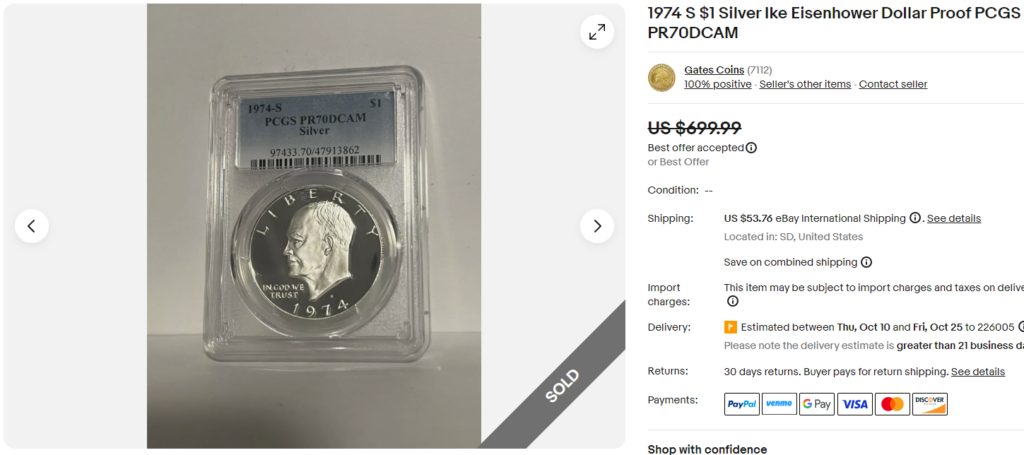
1974 Dollar Clad Proof Coins
In addition to the silver coins, the United States Mint released around 2,612,568 clad-proof Eisenhower Dollars in 1974, featuring the original 75% copper and 25% nickel composition at the San Francisco Mint.
These proof coins are also categorized as PR, CAM, and DCAM, with DCAM examples being the most expensive. The value of 1974 $1 DCAM proof ranges from $10 to $40 for $PR60 to PR69 grades, while the PR70 coins can reach $4,500 to $9,000 or more!
Both CAM and regular proof coins are worth around $10 to $25 or slightly more, depending on the condition!
4. Rare 1974 Eisenhower Dollar Minting Errors List
Minting errors that happen during the striking process can also enhance a 1974 dollar coin value. Here are the most notable 1974 dollar mint errors to look for:
Struck on a 40% Silver Planchet
This is the most popular and expensive error for a 1974 Eisenhower Dollar, in which a no mint mark or D-mint mark coin (clad versions) is struck on silver planchet (intended only for 1974-S $1).
These silver dollar error coins can be extremely valuable today, fetching $4,000 to $12,000 or more, like this one I found on Heritage Auctions that was bought for a whopping $11,100!
Obverse Struck Through Duct Tape
A “struck through” error happens when a foreign material gets stuck to the coin’s die during the striking process, impressing to the coin’s surface. In this case, it’s a piece of duct tape that got struck on a 1974 Eisenhower Dollar obverse. You can identify it b y dark markings or streaks.
A rare MS64 example of this error coin sold for $940 in a coin auction! Generally, MS64 no mint mark dollar coins are worth only $8 to $20.
Struck on a 1974 D Dime
This error happened when a 1974 D dollar was mistakenly struck on a 1974-D dime planchet. This rare coin would be different in size and weight than a regular 1974 dollar. In certain cases, you may also find the double struck features, like this MS65 coin that sold for a staggering record price of over $14,000 on Heritage Auctions!
Reverse Indented by Cent Planchet
In this specific error, a cent (penny) planchet somehow got stuck to the reverse die of the Eisenhower dollar during the minting process. When the 1974 dollar was struck, the penny blank left an indentation on its reverse.
You can easily identify this 1974 dollar error by an empty dent the size of a penny on the surface. An MS62 example of this rare error coin was auctioned for $2,530 at Heritage Auctions, a rare price for a 1974 one dollar coin in this grade!
How to Know If a 1974 Eisenhower Dollar Is Silver?
If you’re confused about whether your 1974 one-dollar coin is silver or not, follow these four simple steps:
- Check the Composition: Use a magnet. Neither silver nor copper nickel clad is magnetic, so if a 1974 dollar coin is attracted to a magnet, it’s likely a fake.
- Check the Mint Mark: 1974 silver dollars were minted at the San Francisco Mint and will have an “S” mint mark on the obverse. The lack of the mint mark indicates a clad version.
- Weigh the Coin: Use a precise scale to weigh your 1974 dollar. The silver version is 24.62 grams, while the clad version is 22.68 grams.
- Check Edge Color: Silver dollar coins have a unique luster, feel, and edge color compared to clad coins.
In case of any doubt, contact a professional coin grading service for proper authentication and grading.


